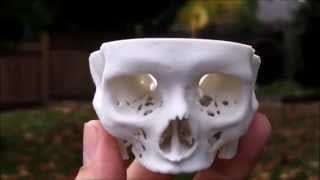This post is courtesy of a guest writer, Josh Weinberger.
3-D Printing and the law have always been strange bed partners; from Cody Wilson’s 3-D printed gun to a range of intellectual property concerns and disputes. But as this technology matures, you will see it more and more in the courtroom. Rather than being on the stand it’s now being used by prosecutors and defense attorneys alike as a tool in litigation. 3D Printed Evidence, founded by Josh Weinberger, a former Stetson University Law Student 3D prints an array of demonstrative aids from topographical models, small scale replicas of vehicular crashes, to scaled down crime scenes, and even broken bones and other related injuries directly from MRI’s and CT scans.
3-D Printed Models v. Traditional Demonstrative Aids:
The advantages of 3-D printing are truly tangible. It helps juries relate to the facts they’re faced with. The 3D aspect allows for greater spatial appreciation of the evidence being presented; as opposed to cardboard cut outs, foam models, or viewing pictures, power points, or even animations. Having an exact replica that jury members can touch and hold in their own hands gives them a greater understanding and helps illuminate the case.
While small-scale casts, foam cutouts, and rudimentary models have been used in courtrooms for quite some time, it’s historically been an arduous process due to the design elements, lack of predictability in material, timeframe, and costs. “3D Printed Evidence makes the process of creating effective demonstrative evidence simple and affordable,” – says Weinberger. Medical models are anatomically correct, as they are derived directly from the patients MRI’s or Ct Scans.
With sophisticated 3-D software it is now possible to convert medical image data (MRI, CT, Micro-CT, and Ultrasound data) into 3-D models. Medical investigators will use 3D printing to help solve crimes by recreating organs which were damaged or ruptured and will help provide attorneys with visual aids. Using three dimensional models of organs or sections of the body can help investigators or testifying medical experts to visually inspect bullet holes, fragmentations, stab wounds, and impact trauma. In a recent case involving medical malpractice, a 3D printer created a model of the body part in question, displaying the injury in tangle terms.
While in court, a fingerprint examiner could use a large replica of a suspect’s fingerprint to make identifications and comparisons by color coding certain ridge features (such as islands, crossovers, and bifurcations) matching them to a print at a crime scene. Jurors benefit by being able to easily visualize the 3D replica and they have the benefit of haptic perception.
The 3D models are printed on their Projet 4500 from 3D Systems. This Particular 3-D Printer enables users to print in continuous-tone full-color plastic. It uses 3DS’ ColorJet Printing (CJP) technology and delivers full-color and durable plastic parts straight out of the printer. ColorJet Printing (CJP) involves two major components: core and binder. Core material a plastic powder: VisiJet C4 Spectrum is spread in thin layers over the build platform with a roller. After each layer of core material is spread, color binder is selectively jetted from inkjet print heads over the core layer, causing the core to solidify. The build platform lowers with each subsequent layer of core and binder until the model is complete.
Having effective evidence can be a vital instrument in settling the case in your client’s favor. Combined with 3D printing, the options for creating these persuasive models are limitless. It’s only a matter of time before 3D Printed Evidence is utilized in every courtroom.
Author Contact Information:
Josh Weinberger
3Dprintedevidence.com/
JoshWeinberger3DE@gmail.com



Join the conversation!